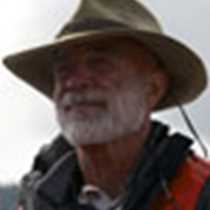Isla Monserrate
The dawn broke this morning with beautiful reds and oranges and a rising wind from the southeast. The southeast is an unusual wind here in the Gulf of California and often foreshadows a storm system moving down from the north. Sure enough, the wind rose through the morning and the increased sea state made our search for whales difficult. Hours of intense hunting turned up one young adult male sea lion and a lone bottlenose dolphin but no whales. Even our ace in the hole, a slide illustrated talk on geology, failed to turn up a whale!
By early afternoon, as we dropped anchor at Isla Monserrate, clouds covered the sky and rain began to fall. This island is seldom visited by anyone, even the Lindblad ships, so most of us decided to brave the weather and go ashore to explore. The rich smell of wet desert freshness greeted us as we disembarked the Zodiacs on a pristine white beach and followed one of our naturalists or investigated on our own. Behind the beach and along the arroyos were beautifully eroded and sculpted sandstone cliffs that contained layers of 10,000-year-old seafloor sediments. Although we had failed to find whales on the sea this morning, our whale hunt was not over yet. Imbedded in the sandstones at the head of a particularly stunning arroyo was the partially fossilized rib of a whale. There was no way to identify the whale species from the bone fragment, but we thought about the life and death of this sea creature that swam the waters of the Gulf so many years ago—a fitting speculation for the last afternoon of this year. Some digging around in the cliffs also uncovered shark’s teeth, a wide variety of shells and a dolphin tooth.
We tailored our evening to old Swedish tradition and sent love and best wishes to those in far away places as the oldest person aboard rang out the old year with 8 bells and the youngest person rang in the new year with another 8 bells. All of us aboard the Sea Bird wish all of you Feliz Año Nuevo!
The dawn broke this morning with beautiful reds and oranges and a rising wind from the southeast. The southeast is an unusual wind here in the Gulf of California and often foreshadows a storm system moving down from the north. Sure enough, the wind rose through the morning and the increased sea state made our search for whales difficult. Hours of intense hunting turned up one young adult male sea lion and a lone bottlenose dolphin but no whales. Even our ace in the hole, a slide illustrated talk on geology, failed to turn up a whale!
By early afternoon, as we dropped anchor at Isla Monserrate, clouds covered the sky and rain began to fall. This island is seldom visited by anyone, even the Lindblad ships, so most of us decided to brave the weather and go ashore to explore. The rich smell of wet desert freshness greeted us as we disembarked the Zodiacs on a pristine white beach and followed one of our naturalists or investigated on our own. Behind the beach and along the arroyos were beautifully eroded and sculpted sandstone cliffs that contained layers of 10,000-year-old seafloor sediments. Although we had failed to find whales on the sea this morning, our whale hunt was not over yet. Imbedded in the sandstones at the head of a particularly stunning arroyo was the partially fossilized rib of a whale. There was no way to identify the whale species from the bone fragment, but we thought about the life and death of this sea creature that swam the waters of the Gulf so many years ago—a fitting speculation for the last afternoon of this year. Some digging around in the cliffs also uncovered shark’s teeth, a wide variety of shells and a dolphin tooth.
We tailored our evening to old Swedish tradition and sent love and best wishes to those in far away places as the oldest person aboard rang out the old year with 8 bells and the youngest person rang in the new year with another 8 bells. All of us aboard the Sea Bird wish all of you Feliz Año Nuevo!




